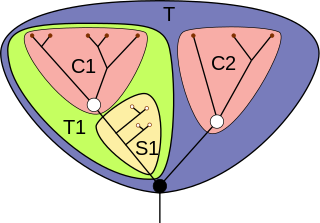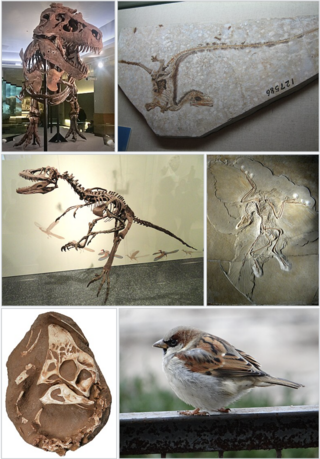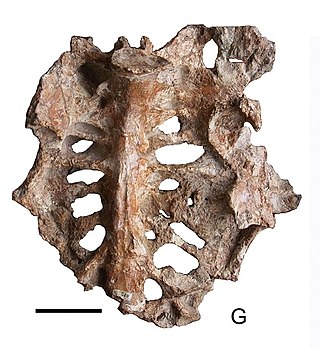
Archaeopteryx, sometimes referred to by its German name, "Urvogel" is a genus of bird-like dinosaurs. The name derives from the ancient Greek ἀρχαῖος (archaīos), meaning "ancient", and πτέρυξ (ptéryx), meaning "feather" or "wing". Between the late 19th century and the early 21st century, Archaeopteryx was generally accepted by palaeontologists and popular reference books as the oldest-known bird. Older potential avialans have since been identified, including Anchiornis, Xiaotingia, and Aurornis.

Dinosaurs are a diverse group of reptiles of the clade Dinosauria. They first appeared during the Triassic period, between 243 and 233.23 million years ago (mya), although the exact origin and timing of the evolution of dinosaurs is a subject of active research. They became the dominant terrestrial vertebrates after the Triassic–Jurassic extinction event 201.3 mya and their dominance continued throughout the Jurassic and Cretaceous periods. The fossil record shows that birds are feathered dinosaurs, having evolved from earlier theropods during the Late Jurassic epoch, and are the only dinosaur lineage known to have survived the Cretaceous–Paleogene extinction event approximately 66 mya. Dinosaurs can therefore be divided into avian dinosaurs—birds—and the extinct non-avian dinosaurs, which are all dinosaurs other than birds.

A passerine is any bird of the order Passeriformes which includes more than half of all bird species. Sometimes known as perching birds, passerines generally have an anisodactyl arrangement of their toes, which facilitates perching.

Falcons are birds of prey in the genus Falco, which includes about 40 species. Falcons are widely distributed on all continents of the world except Antarctica, though closely related raptors did occur there in the Eocene.

The Coraciiformes are a group of usually colourful birds including the kingfishers, the bee-eaters, the rollers, the motmots, and the todies. They generally have syndactyly, with three forward-pointing toes, though in many kingfishers one of these is missing. The members of this order are linked by their “slamming” behaviour, thrashing their prey onto surfaces to disarm or incapacitate them.

Gastornis is an extinct genus of large, flightless birds that lived during the mid-Paleocene to mid-Eocene epochs of the Paleogene period. Fossils have been found in Europe, Asia and North America, with the North American specimens formerly assigned to the genus Diatryma.

Ostriches are large flightless birds. They are the heaviest and largest living birds, with adult common ostriches weighing anywhere between 63.5 and 145 kilograms and laying the largest eggs of any living land animal. With the ability to run at 70 km/h (43.5 mph), they are the fastest birds on land. They are farmed worldwide, with significant industries in the Philippines and in Namibia. Ostrich leather is a lucrative commodity, and the large feathers are used as plumes for the decoration of ceremonial headgear. Ostrich eggs have been used by humans for millennia.

In phylogenetics, the crown group or crown assemblage is a collection of species composed of the living representatives of the collection, the most recent common ancestor of the collection, and all descendants of the most recent common ancestor. It is thus a way of defining a clade, a group consisting of a species and all its extant or extinct descendants. For example, Neornithes (birds) can be defined as a crown group, which includes the most recent common ancestor of all modern birds, and all of its extant or extinct descendants.

Coelurosauria is the clade containing all theropod dinosaurs more closely related to birds than to carnosaurs.

Ichthyornis is an extinct genus of toothy seabird-like ornithuran from the late Cretaceous period of North America. Its fossil remains are known from the chalks of Alberta, Alabama, Kansas, New Mexico, Saskatchewan, and Texas, in strata that were laid down in the Western Interior Seaway during the Turonian through Campanian ages, about 95–83.5 million years ago. Ichthyornis is a common component of the Niobrara Formation fauna, and numerous specimens have been found.

Palaeognathae is an infraclass of birds, called paleognaths or palaeognaths, within the class Aves of the clade Archosauria. It is one of the two extant infraclasses of birds, the other being Neognathae, both of which form Neornithes. Palaeognathae contains five extant branches of flightless lineages, termed ratites, and one flying lineage, the Neotropic tinamous. There are 47 species of tinamous, five of kiwis (Apteryx), three of cassowaries (Casuarius), one of emus (Dromaius), two of rheas (Rhea) and two of ostriches (Struthio). Recent research has indicated that paleognaths are monophyletic but the traditional taxonomic split between flightless and flighted forms is incorrect; tinamous are within the ratite radiation, meaning flightlessness arose independently multiple times via parallel evolution.

The evolution of birds began in the Jurassic Period, with the earliest birds derived from a clade of theropod dinosaurs named Paraves. Birds are categorized as a biological class, Aves. For more than a century, the small theropod dinosaur Archaeopteryx lithographica from the Late Jurassic period was considered to have been the earliest bird. Modern phylogenies place birds in the dinosaur clade Theropoda. According to the current consensus, Aves and a sister group, the order Crocodilia, together are the sole living members of an unranked reptile clade, the Archosauria. Four distinct lineages of bird survived the Cretaceous–Paleogene extinction event 66 million years ago, giving rise to ostriches and relatives (Palaeognathae), waterfowl (Anseriformes), ground-living fowl (Galliformes), and "modern birds" (Neoaves).

Gansus is a genus of aquatic birds that lived during the Aptian age of the Early Cretaceous (Aptian-Albian) period in what are now Gansu and Liaoning provinces, western China. The rock layers from which their fossils have been recovered are dated to 120 million years ago. It was first described in 1984 on the basis of an isolated left leg. It is the oldest-known member of the Ornithurae, the group which includes modern birds (Neornithes) and extinct related groups, such as Ichthyornis and Hesperornithes.

Gargantuavis is an extinct genus of large, primitive bird containing the single species Gargantuavis philoinos. It is the only member of the monotypic family Gargantuaviidae. Its fossils were discovered in several formations dating to 73.5 and 71.5 million years ago in what is now northern Spain, southern France, and Romania. Gargantuavis is the largest known bird of the Mesozoic, a size ranging between the cassowary and the ostrich, and a mass of 141 kg (311 lb) like modern ostriches, exemplifying the extinction of non-avian dinosaurs was not a necessary condition for the emergence of giant terrestrial birds. It was once thought to be closely related to modern birds, but the 2019 discovery of a pelvis from what was Hateg Island shows several primitive features.

Sinornis is a genus of enantiornithean birds from the Lower Cretaceous Jiufotang Formation of the People's Republic of China.
Chaoyangia is an extinct genus of euornithean birds, containing the single species Chaoyangia beishanensis. This species is known from a single fossil specimen consisting of a partial skeleton including vertebra, ribs, hips, and upper legs. The specimen was discovered in the Jiufotang Formation near the city of Chaoyang in Liaoning province, China. This rock formation has been dated to the Aptian age of the Early Cretaceous period, 120 million years ago.

Aurornis is an extinct genus of anchiornithid theropod dinosaurs from the Jurassic period of China. The genus Aurornis contains a single known species, Aurornis xui. Aurornis xui may be the most basal ("primitive") avialan dinosaur known to date, and it is one of the earliest avialans found to date. The fossil evidence for the animal pre-dates that of Archaeopteryx lithographica, often considered the earliest bird species, by about 10 million years.
Australornis is a genus of extinct seabird discovered in New Zealand. It lived in the Paleocene epoch, 60.5 to 61.6 million years ago (Ma). The type species name originates from australis, Latin for "southern", and ornis, the Greek word for "bird", and lovei commemorates Leigh Love, an amateur paleontologist who discovered it.

Avimaia is a genus of fossil birds of the Enantiornithes clade that lived about 115 million years ago in Northwest China. The only known species is A. schweitzerae. The holotype fossil of the bird was found in the Xiagou Formation, and is noted as the first discovered fossil bird with an unlaid egg. Abnormalities, including egg binding in which the egg becomes stuck within the body of the bird causing death, were found in the egg suggesting that the preserved egg may have caused this bird's demise. Egg binding is a serious and lethal condition that is fairly common in small birds undergoing stress.
Janavis is an extinct toothed bird, belonging to the Ichthyornithes, from the Late Cretaceous of Belgium. The genus has one named species, Janavis finalidens that was discovered in the 1990s, reported in 2002, and described in 2022. Recovered almost simultaneously from the same area and age as Asteriornis maastrichtensis, then the oldest known modern bird, it provides information on the evolution and divergence of basal and modern birds, especially on the evolutionary modifications of bird skulls.















